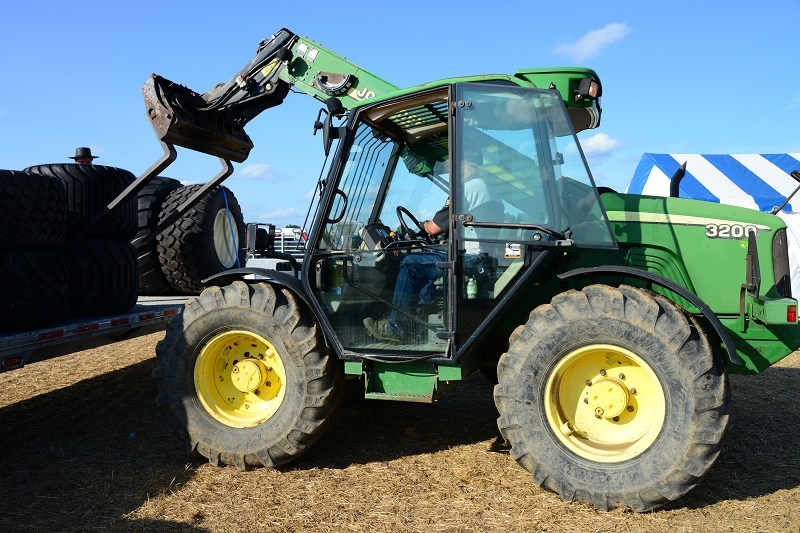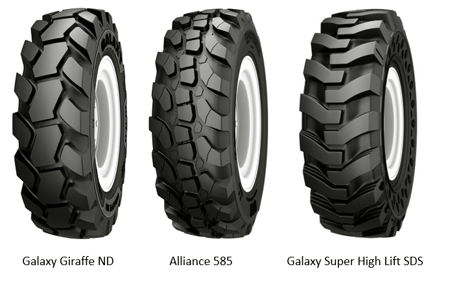The Pros and Cons of the Different Types of Telehandler Tires
Telehandler owners/operators ask a lot of their tires—they need to transmit a machine’s power, provide stability when moving a load at height, operate in a variety of terrains, and stand up to regular use. Consequently, equipping a telehandler with the right tire will have an enormous effect on its performance, improving everything from productivity and safety to profit. But what type of telehandler tire to choose?

Three Types of Telehandler Tires
There are three types of telehandler tire each with its own set of pros and cons:
- Pneumatic (bias and radial)
- Solid
- Foam-filled
Pneumatic Telehandler Tires
The definition of pneumatic is “containing or operated by air.” Because pneumatic tires are air filled and don’t use expensive foam or the massive amount of rubber found in other tire types, they’re generally the most affordable telehandler tire option. There are two types of pneumatic tires available—radials and bias—and while radials are gaining popularity for use on telehandlers in some markets such as Europe, most machines in North America are equipped with bias tires.
Pneumatic Telehandler Tire Pros
In addition to their typically lower cost, pneumatic tires offer better traction on soft surfaces and uneven terrain, and because of their comparatively low weight, they provide superior floatation. All of this adds up to tires well suited for telehandlers operating on soft or muddy surfaces. Another benefit of air-filled tires is the soft ride they provide, which is easier on operators and reduces wear and tear on machines.
Pneumatic Telehandler Tire Cons
The downside of pneumatic telehandler tires is that they’re vulnerable to puncture. Flat tires on telehandlers are not just disruptive with downtime, they’re dangerous if a flat occurs with a load in the air.
Solid Telehandler Tires
Solids live up to their name, as they’re made of solid rubber. Solids have the highest up-front cost and are the longest-lasting of the different types of telehandler tires. However, the comparatively high initial investment doesn’t tell the whole solid tire story. Solid tires are puncture proof, which eliminates costly tire-induced downtime, and will last anywhere from three to four times longer than pneumatic tires, which often results in them having the lowest total cost of ownership.
Solid Telehandler Tire Pros
The solid rubber construction of these tires means that they’re resistant to cuts and punctures, and there is a lot of rubber to wear away which makes them super-long lasting. Another benefit of solid construction is that the tires require very little maintenance—for example, there’s no need to monitor air pressure. Because the tires are solid rubber, they’re heavy, which creates an extremely stable platform for the machine to operate.
Solid Telehandler Tire Cons
The drawbacks of solid tires are that their weight and rigid footprint don’t translate as well to soft surfaces as other types of telehandler tires. A firm ride is a also noticeable characteristic of solid tires—some operators find them comparatively harsh, although others appreciate the stability they provide.
Foam-Filled Telehandler Tires
Foam-filled tires typically split the difference between a pneumatic tire and a solid tire—their cost and lifespan are generally greater than that of a pneumatic, but less than that of a solid. Commonly, bias tires are chosen for foam filling.
Foam-Filled Telehandler Tire Pros
The weight of the foam makes these tires heavier than their pneumatic counterparts while still allowing the tire to put a favorable footprint on the ground—all of this adds up to stability when lifting loads on uneven terrain. Another advantage of foam-filled tires is their increased puncture resistance when compared to a traditional air-filled tire.
Foam-Filled Telehandler Tire Cons
While this type of tire benefits from improved puncture protection, they’re not immune to destruction, especially on their sidewalls. Also, pneumatic tires are engineered to operate inflated with air, not foam—because of this, foam-filled tires can hasten tire wear and shorten their life. This is particularly true of tires not foam-filled by an expert.
Take Your Telehandler's Performance to New Heights
No matter what tire type you choose for your telehandler, Yokohama Off-Highway Tires has an option for you. Pneumatics, like our Giraffe ND, are made to handle the unique challenges telehandlers place on their tires and are engineered to stand up to hard days and foam filling. Radial pneumatics, such as our Alliance 585, are taking telehandler performance to the next level by boosting machine performance, improving operator comfort, and reducing downtime. For the toughest jobs and conditions, tires like our Galaxy Super High Lift SDS, have a reputation for thriving in the harshest applications. 

Contact your local Yokohama Off-Highway Tires dealer or rep to learn more about our extensive line of telehandler tires.

